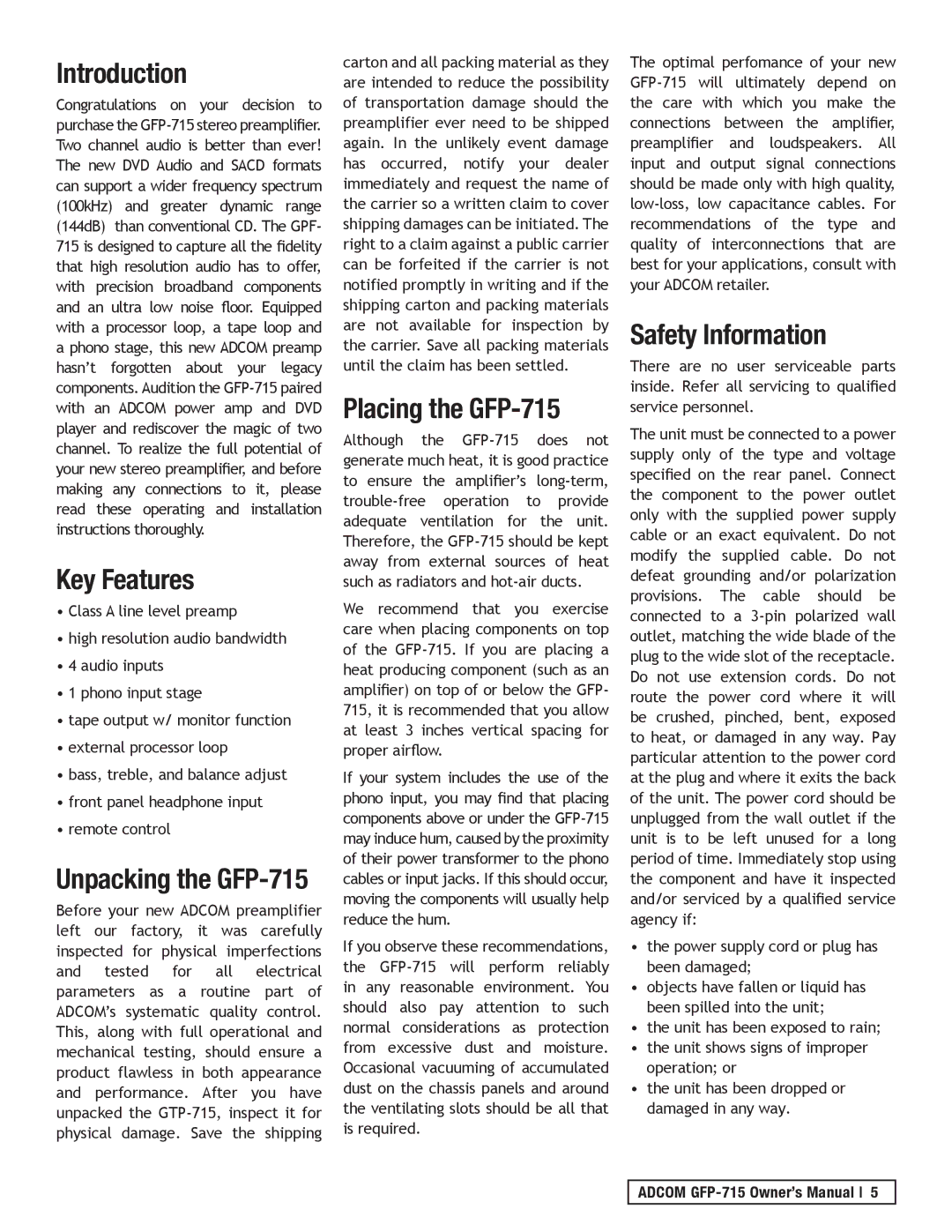Introduction
Congratulations on your decision to purchase the GFP-715 stereo preamplifier. Two channel audio is better than ever! The new DVD Audio and SACD formats can support a wider frequency spectrum (100kHz) and greater dynamic range (144dB) than conventional CD. The GPF- 715 is designed to capture all the fidelity that high resolution audio has to offer, with precision broadband components and an ultra low noise floor. Equipped with a processor loop, a tape loop and a phono stage, this new ADCOM preamp hasn’t forgotten about your legacy components. Audition the GFP-715 paired with an ADCOM power amp and DVD player and rediscover the magic of two channel. To realize the full potential of your new stereo preamplifier, and before making any connections to it, please read these operating and installation instructions thoroughly.
Key Features
•Class A line level preamp
•high resolution audio bandwidth
•4 audio inputs
•1 phono input stage
•tape output w/ monitor function
•external processor loop
•bass, treble, and balance adjust
•front panel headphone input
•remote control
Unpacking the GFP-715
Before your new ADCOM preamplifier left our factory, it was carefully inspected for physical imperfections and tested for all electrical parameters as a routine part of ADCOM’s systematic quality control. This, along with full operational and mechanical testing, should ensure a product flawless in both appearance and performance. After you have unpacked the GTP-715, inspect it for physical damage. Save the shipping
carton and all packing material as they are intended to reduce the possibility of transportation damage should the preamplifier ever need to be shipped again. In the unlikely event damage has occurred, notify your dealer immediately and request the name of the carrier so a written claim to cover shipping damages can be initiated. The right to a claim against a public carrier can be forfeited if the carrier is not notified promptly in writing and if the shipping carton and packing materials are not available for inspection by the carrier. Save all packing materials until the claim has been settled.
Placing the GFP-715
Although the GFP-715 does not generate much heat, it is good practice to ensure the amplifier’s long-term, trouble-free operation to provide adequate ventilation for the unit. Therefore, the GFP-715 should be kept away from external sources of heat such as radiators and hot-air ducts.
We recommend that you exercise care when placing components on top of the GFP-715. If you are placing a heat producing component (such as an amplifier) on top of or below the GFP- 715, it is recommended that you allow at least 3 inches vertical spacing for proper airflow.
If your system includes the use of the phono input, you may find that placing components above or under the GFP-715 may induce hum, caused by the proximity of their power transformer to the phono cables or input jacks. If this should occur, moving the components will usually help reduce the hum.
If you observe these recommendations, the GFP-715 will perform reliably in any reasonable environment. You should also pay attention to such normal considerations as protection from excessive dust and moisture. Occasional vacuuming of accumulated dust on the chassis panels and around the ventilating slots should be all that is required.
The optimal perfomance of your new GFP-715 will ultimately depend on the care with which you make the connections between the amplifier, preamplifier and loudspeakers. All input and output signal connections should be made only with high quality, low-loss, low capacitance cables. For recommendations of the type and quality of interconnections that are best for your applications, consult with your ADCOM retailer.
Safety Information
There are no user serviceable parts inside. Refer all servicing to qualified service personnel.
The unit must be connected to a power supply only of the type and voltage specified on the rear panel. Connect the component to the power outlet only with the supplied power supply cable or an exact equivalent. Do not modify the supplied cable. Do not defeat grounding and/or polarization provisions. The cable should be connected to a 3-pin polarized wall outlet, matching the wide blade of the plug to the wide slot of the receptacle. Do not use extension cords. Do not route the power cord where it will be crushed, pinched, bent, exposed to heat, or damaged in any way. Pay particular attention to the power cord at the plug and where it exits the back of the unit. The power cord should be unplugged from the wall outlet if the unit is to be left unused for a long period of time. Immediately stop using the component and have it inspected and/or serviced by a qualified service agency if:
•the power supply cord or plug has been damaged;
•objects have fallen or liquid has been spilled into the unit;
•the unit has been exposed to rain;
•the unit shows signs of improper operation; or
•the unit has been dropped or damaged in any way.
